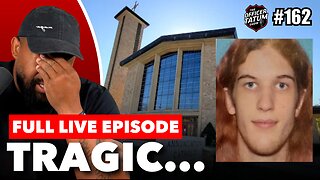Premium Only Content

Episode 1474: What does Lex orandi, lex credendi mean?
Lex orandi, lex credendi is a Latin phrase that means "the law of prayer is the law of belief." It is a principle in Catholic theology that states that the way we pray is a reflection of what we believe. In other words, our worship practices shape our understanding of God and our faith.
The phrase is often attributed to Prosper of Aquitaine, a fifth-century Christian writer. However, the idea itself can be traced back to the early Church. For example, the Didache, an early Christian document, states that "the one who prays ought to pray as follows." This suggests that the early Christians believed that there was a right way to pray, and that this way of praying was rooted in their beliefs about God.
The principle of Lex orandi, lex credendi has been used to explain a number of things about Christian worship and theology. For example, it has been used to explain why the early Christians prayed for the dead, even though there is no explicit command to do so in the Bible. The principle has also been used to explain why the Christian faith has developed over time, as our understanding of God has grown and changed.
In recent years, the principle of Lex orandi, lex credendi has been used to argue for a more liturgically-oriented approach to theology. This approach emphasizes the importance of worship as a way of learning about God and growing in faith. It also argues that our worship practices should be shaped by our beliefs, rather than the other way around.
The principle of Lex orandi, lex credendi is a reminder that our worship practices are not just a matter of personal preference. They are also a way of expressing our beliefs about God and our faith. When we pray, we are not just talking to God. We are also telling ourselves who God is and what we believe about him.
Here are some examples of how the principle of Lex orandi, lex credendi is applied to Catholics:
The way we pray the Lord's Prayer reflects our belief in God as a loving Father who hears our prayers.
The way we celebrate the Eucharist reflects our belief in the real presence of Christ in the bread and wine.
The way we baptize infants reflects our belief that all people are born with original sin and need to be cleansed by the waters of baptism.
The principle of Lex orandi, lex credendi is a valuable reminder that our worship practices are not just a matter of personal preference. They are also a way of expressing our beliefs about God and our faith. When we pray, we are not just talking to God. We are also telling ourselves who God is and what we believe about him.
The principle of Lex orandi, lex credendi states that the way we pray is a reflection of what we believe. In other words, our worship practices shape our understanding of God and our faith.
After Second Vatican Council in 1969, there have been a number of changes to the Catholic Mass, (although nit approved by V2) including the introduction of the Novus Ordo Mass. These changes have decline the quality of Catholic worship and a loss of understanding of the Catholic faith. The traditional theology and the mass go hand in hand. That’s why in order to change the mass they had to first abandon the theology.
One of the main criticisms of the Novus Ordo Mass is that it is too informal and lacks the traditional beauty and solemnity of the Tridentine Mass. The use of the vernacular language, for example, has been seen as a way of watering down the Mass and making it less meaningful.
Let me describe what I saw at the outdoor mass at the feast this past weekend.
Another criticism is that the Novus Ordo Mass is too focused on the participation of the laity, at the expense of the role of the priest. The Persona Christi and Christ himself. It became just like the Book of Common Prayer the protestants use. This has led to a loss of the sense of mystery and awe that is traditionally associated with the Mass. The prayer was shattered.
The Novus Ordo Mass does not adequately reflect the Catholic faith. The Mass has been revised to remove references to certain Catholic doctrines, such as the Real Presence of Christ in the Eucharist.
Many people believe that the Mass has been improved by the changes that have been made. Ultimately, the question of whether or not the Lex orandi, lex credendi has changed detrimentally since 1969 and I say Absoutely. I know because I left it.
Here are some specific examples of how the Lex orandi, lex credendi has changed since 1969:
The use of the vernacular language in the Mass has made it more accessible to people who do not understand Latin. However, it has also been criticized for making the Mass less solemn and reverent.
First, Latin is a more formal language than most vernacular languages. It is also a language that is associated with the Church, and its use in the Mass can help to create a sense of awe and reverence.
Second, the vernacular language can be more distracting than Latin. When people are not familiar with the language, they may be more likely to be distracted by the words themselves, or by the way they are being spoken. This can make it difficult to focus on the meaning of the Mass and to experience its full solemnity.
Third, the use of the vernacular language can make it more difficult to maintain a sense of unity during the Mass. When people are not all speaking the same language, it can be more difficult to feel like they are all participating in the same event. This can make the Mass feel less unified and less reverent.
The introduction of more flexible and participatory forms of worship has been welcomed by some people, but it has also been criticized for detracting from the traditional focus on the priest and the altar. The traditional focus on the priest and the altar in the Catholic Mass is based on the belief that the Mass is a sacrifice that is offered by the priest on behalf of the people. The priest is seen as the mediator between God and the people, and the altar is seen as the place where the sacrifice is offered.
The introduction of more flexible and participatory forms of worship has been criticized for detracting from this traditional focus. For example, the fact that the people are now encouraged to participate more actively in the Mass, such as by reading the Scripture readings or leading the prayers, can be seen as taking away from the role of the priest.
Similarly, the fact that the altar is now often placed in the center of the sanctuary, rather than at the back, can be seen as detracting from its sacredness. This is because the altar is now more accessible to the people, and it is no longer seen as a place that is set apart from the rest of the church.
The removal of certain references to Catholic doctrine from the Mass has been seen by some as a watering down of the faith.
First, these references can help to remind people of the Catholic faith and its teachings. For example, the removal of the words "transubstantiation" and "real presence" from the Mass can make it more difficult for people to understand the Catholic belief that the bread and wine become the Body and Blood of Christ during the Mass.
Second, these references can help to create a sense of unity among Catholics. When people share a common understanding of the faith, it can help them to feel more connected to each other and to the Church. The removal of these references can make it more difficult for people to feel this sense of unity.
Third, these references can help to challenge people to grow in their faith. When people are reminded of the Catholic faith and its teachings, it can help them to reflect on their own beliefs and to make sure that they are in line with the Church's teachings. The removal of these references can make it more difficult for people to grow in their faith.
Many Novus Ordo catholics argue that these changes were necessary to make the Mass more accessible to people who do not understand the Catholic faith. They point out that the meaning of the Mass is not dependent on the specific words that are used, and that the Mass can still be a powerful and meaningful experience, even when it is celebrated without these references. So instead of educating the faithful we dummy it down?
Here are some specific examples of references to Catholic doctrine that have been removed from the Mass:
The words "transubstantiation" and "real presence" have been removed from the description of the Eucharist.
The word "transubstantiation" refers to the Catholic belief that the bread and wine become the Body and Blood of Christ during the Mass. The word "real presence" refers to the Catholic belief that Christ is truly present in the Eucharist, in a way that is both physical and spiritual.
The removal of these words from the Novus Ordo Mass was controversial, and it is still a matter of debate among Catholics. Some people argue that the removal of these words was a watering down of the faith, while others argue that it was necessary to make the Mass more accessible to people who do not understand the Catholic faith.
The replacement for the words "transubstantiation" and "real presence" in the Novus Ordo Mass is the phrase "the mystery of faith." This phrase is more general and does not explicitly state the Catholic belief in the Real Presence. However, it does affirm that the Eucharist is a sacred mystery that we cannot fully understand.
The following is an example of how the words "transubstantiation" and "real presence" were replaced in the Novus Ordo Mass:
In the traditional Latin Mass, the priest would say, "Hoc est enim corpus meum" (This is my Body).
In the Novus Ordo Mass, the priest would say, "This is the mystery of faith" (Mysterium fidei).
The removal of the words "transubstantiation" and "real presence" from the Novus Ordo Mass has been interpreted in different ways by different people. Some people believe that it is a sign of a decline in the Catholic faith, while others believe that it is a necessary step to make the Mass more accessible to people who do not understand the Catholic faith. Ultimately, the interpretation of this change is a matter of personal belief.
The words "sacrifice" and "altar" have been removed from the description of the Mass.
The word "sacrifice" refers to the Catholic belief that the Mass is a re-presentation of the sacrifice of Christ on the cross. The word "altar" refers to the place where the Mass is celebrated, which is traditionally seen as a sacred space where the sacrifice of Christ is offered.
The removal of these words from the Novus Ordo Mass was controversial, and it is still a matter of debate among Catholics. Some people argue that the removal of these words was a watering down of the faith, while others argue that it was necessary to make the Mass more accessible to people who do not understand the Catholic faith.
The replacement for the words "sacrifice" and "altar" in the Novus Ordo Mass is the phrase "the table of the Lord." This phrase is more general and does not explicitly state the Catholic belief in the Mass as a sacrifice. However, it does affirm that the Eucharist is a sacred meal that we celebrate in union with Christ.
The following is an example of how the words "sacrifice" and "altar" were replaced in the Novus Ordo Mass:
In the traditional Latin Mass, the priest would say, "Hanc igitur oblationem." (Therefore, we offer you.)
In the Novus Ordo Mass, the priest would say, "Offerimus tibi, Domine, calicem salutaris." (We offer you, Lord, the chalice of salvation.)
The removal of the words "sacrifice" and "altar" from the Novus Ordo Mass has been interpreted in different ways by different people. Some people believe that it is a sign of a decline in the Catholic faith, while others believe that it is a necessary step to make the Mass more accessible to people who do not understand the Catholic faith. Ultimately, the interpretation of this change is a matter of personal belief.
The words "Mary" and "saints" have been removed from some of the prayers.
The removal of these words was controversial, and it is still a matter of debate among Catholics. Some people argue that the removal of these words was a watering down of the faith, while others argue that it was necessary to make the Mass more accessible to people who do not understand the Catholic faith.
The following are some examples of prayers in which the words "Mary" and "saints" have been removed:
The Confiteor, a prayer of confession, used to include an invocation of Mary and the saints.
The Offertory prayers, which are said by the priest as he prepares the bread and wine for the Eucharist, used to include invocations of Mary and the saints.
The Prayers of the Faithful, which are said by the congregation, used to include prayers for the intercession of Mary and the saints.
The removal of the words "Mary" and "saints" from these prayers has been interpreted in different ways by different people. Some people believe that it is a sign of a decline in the Catholic faith, while others believe that it is a necessary step to make the Mass more accessible to people who do not understand the Catholic faith. Ultimately, the interpretation of this change is a matter of personal belief.
It is important to note that the Catholic Church still teaches that Mary and the saints are important intercessors for us. However, the Church also recognizes that these terms can be confusing or off-putting to some people. Therefore, the Novus Ordo Mass uses more general language that is more likely to be understood by a wider audience.
The Catholic Church also teaches that the Mass is a sacrifice that is offered to God by Christ, and that it is not necessary to invoke Mary or the saints in order to make this sacrifice valid. However, many Catholics believe that it is still a good practice to invoke Mary and the saints, and that these prayers can help us to grow in our faith.
So lets see the results of this change in Lex Orandi of 1969:
According to a 2020 study by the Pew Research Center, the percentage of U.S. Catholics who attended Mass weekly declined from 78% in 1969 to 39% in 2020. This represents a decline of 39 percentage points.
The study also found that the decline in Mass attendance has been particularly pronounced among younger Catholics. In 1969, 84% of Catholics under the age of 30 attended Mass weekly. By 2020, that number had fallen to 28%.
In fact, it is a trend that is being seen in many Western countries. For example, in Ireland, the percentage of Catholics who attended Mass weekly declined from 92% in 1974 to 35% in 2018.
Sure. There is no definitive answer to this question, as there is no central database that tracks the religious affiliations of individuals. However, there are a number of studies that have been conducted on this topic, and they provide some insights into the number of Catholics who have left the Church to join other churches.
A 2019 study by the Pew Research Center found that 23% of American adults who were raised Catholic no longer identify as Catholic. Of those who left the Church, 37% said they now identify as Protestant, 28% said they are now unaffiliated with any religion, and 18% said they now identify with another religion.
The study also found that the number of Catholics who have left the Church has been increasing in recent years. In 2007, only 17% of American adults who were raised Catholic no longer identified as Catholic.
According to the Center for Applied Research in the Apostolate (CARA), the number of religious priests and nuns in the United States has declined by about 60% since 1965. In 1965, there were about 156,000 religious priests in the United States. By 2020, that number had fallen to about 62,000. The number of religious nuns has declined by an even greater percentage, from about 181,000 in 1965 to about 37,000 in 2020.
According to the National Catholic Reporter, an estimated 19,000 Catholic churches in the United States have closed since 1965. This represents about 1 in 10 Catholic churches in the country.
Here are some additional statistics on the closing of Catholic churches in the United States:
The number of Catholic churches that closed in the United States peaked in the 1970s, with an average of 500 churches closing each year.
The number of Catholic churches that closed has declined in recent years, with an average of 200 churches closing each year.
The majority of Catholic churches that have closed are located in rural areas.
The closing of Catholic churches has had a significant impact on the Catholic community, as it has led to a loss of places of worship and a decrease in the number of priests available to serve parishes.
According to the Pew Research Center, the percentage of Catholic marriages that ended in divorce in the United States increased from 14% in 1965 to 28% in 2019. This represents an increase of 14 percentage points.
The increase in the divorce rate among Catholics is similar to the increase in the divorce rate among all Americans. In 1965, the divorce rate among all Americans was 22%. By 2019, the divorce rate among all Americans had increased to 40%.
There are a number of factors that have contributed to the increase in the divorce rate among Catholics and all Americans. These include:
The changing social and cultural norms around marriage and divorce.
The rise of individualism and the decline of traditional values.
The increasing economic independence of women.
The increasing availability of counseling and other resources for couples experiencing marital problems.
The increase in the divorce rate is a serious challenge for the Catholic Church. However, it is also an opportunity for the Church to reflect on its mission and to find new ways to support couples and families.
Here are some additional statistics on the divorce rate among Catholics:
The divorce rate among Catholics is higher among younger couples. In 2019, the divorce rate among Catholic couples who married between 2010 and 2014 was 34%.
The divorce rate among Catholics is also higher among couples who have been married for a shorter period of time. In 2019, the divorce rate among Catholic couples who had been married for less than 10 years was 31%.
The divorce rate among Catholics is lower among couples who have children. In 2019, the divorce rate among Catholic couples with children was 25%.
A 2019 study by the Pew Research Center found that 29% of American adults who were raised Catholic said they would not get married in a Catholic church, and 27% said they would not be buried in a Catholic cemetery.
The study also found that the number of Catholics who do not get married or buried in the church has been increasing in recent years. In 2007, only 24% of American adults who were raised Catholic said they would not get married in a Catholic church, and 22% said they would not be buried in a Catholic cemetery.
There are a number of factors that may contribute to Catholics choosing not to get married or buried in the church. These include:
Disagreements with Church teachings on issues such as abortion and same-sex marriage.
A desire to find a more personal or spiritual connection with God.
According to a 2022 study by the Pew Research Center, 68% of U.S. Catholics believe that birth control is morally acceptable, and 56% believe that abortion is morally acceptable in some or all circumstances.
These numbers have been steadily increasing in recent years. In 2019, 62% of U.S. Catholics believed that birth control was morally acceptable, and 48% believed that abortion was morally acceptable in some or all circumstances.
There are a number of factors that may contribute to the increasing number of Catholics who believe that birth control and abortion are morally acceptable. These include:
The changing social and cultural norms around these issues.
The increasing availability of information about birth control and abortion.
The personal experiences of Catholics, such as having a family member or friend who has used birth control or had an abortion.
The Catholic Church teaches that artificial birth control is morally wrong, and that abortion is always wrong. However, the Church also teaches that the individual conscience is the ultimate guide for moral decision-making. This means that each Catholic must decide for themselves what they believe is morally acceptable.
A 2019 study by the Pew Research Center found that 18% of U.S. Catholics believe that the bread and wine used in the Eucharist are not literally transformed into the Body and Blood of Christ, but are only symbols of his presence. This is a significant increase from 2007, when only 10% of U.S. Catholics held this belief.
The study also found that the number of Catholics who do not believe in transubstantiation and the real presence is higher among younger Catholics. In 2019, 27% of Catholic adults under the age of 30 held this belief.
There are a number of factors that may contribute to Catholics not believing in transubstantiation and the real presence. These include:
The increasing availability of information about other religions and belief systems.
The decline of religious authority in society.
The personal experiences of Catholics, such as having a family member or friend who does not believe in transubstantiation and the real presence.
The Catholic Church teaches that the bread and wine used in the Eucharist are literally transformed into the Body and Blood of Christ. This is a central tenet of the Catholic faith, and it is one of the seven sacraments.
The increasing number of Catholics who do not believe in transubstantiation and the real presence is a challenge to the Catholic Church.
According to a 2022 study by the Pew Research Center, 63% of U.S. Catholics believe that same-sex relationships are morally acceptable, and 55% believe that same-sex marriage should be legal.
These numbers have been steadily increasing in recent years. In 2019, 57% of U.S. Catholics believed that same-sex relationships were morally acceptable, and 48% believed that same-sex marriage should be legal.
There are a number of factors that may contribute to the increasing number of Catholics who believe that same-sex relationships and marriages are acceptable. These include:
The changing social and cultural norms around these issues.
The increasing availability of information about same-sex relationships and marriages.
The personal experiences of Catholics, such as having a family member or friend who is in a same-sex relationship or marriage.
The Catholic Church teaches that homosexual acts are morally wrong, and that same-sex marriage is not a valid form of marriage. However, the Church also teaches that all people are loved by God and deserve to be treated with respect.
The increasing number of Catholics who believe that same-sex relationships and marriages are acceptable is a challenge to the Catholic Church. However, it is also a sign of the diversity of opinion within the Church. The Church is committed to providing guidance to its members on these issues, but it also respects the individual conscience.
It is important to note that these are just statistics, and they do not reflect the beliefs of all Catholics.
According to a 2022 study by the Pew Research Center, 42% of U.S. Catholics believe that an annulment is not necessary to remarry. This is a significant increase from 2007, when only 33% of U.S. Catholics held this belief.
The study also found that the number of Catholics who believe that an annulment is not necessary to remarry is higher among younger Catholics. In 2022, 52% of Catholic adults under the age of 30 held this belief.
There are a number of factors that may contribute to Catholics not believing that an annulment is necessary to remarry. These include:
The increasing availability of information about other religions and belief systems.
The decline of religious authority in society.
The personal experiences of Catholics, such as having a family member or friend who has remarried without an annulment.
The Catholic Church teaches that an annulment is necessary to remarry in the Catholic Church. This is because the Church believes that marriage is a sacrament, and that a sacrament cannot be broken. An annulment is a declaration by the Church that a marriage was never valid in the first place.
The increasing number of Catholics who believe that an annulment is not necessary to remarry is a challenge to the Catholic Church. However, it is also a sign of the diversity of opinion within the Church. The Church is committed to providing guidance to its members on this issue, but it also respects the individual conscience.
According to a 2019 study by the Pew Research Center, 35% of U.S. Catholics believe that they can receive communion in the state of mortal sin. This is a significant increase from 2007, when only 27% of U.S. Catholics held this belief.
The study also found that the number of Catholics who believe that they can receive communion in the state of mortal sin is higher among younger Catholics. In 2019, 44% of Catholic adults under the age of 30 held this belief.
There are a number of factors that may contribute to Catholics believing that they can receive communion in the state of mortal sin. These include:
The increasing availability of information about other religions and belief systems.
The decline of religious authority in society.
The personal experiences of Catholics, such as having a family member or friend who has received communion in the state of mortal sin.
The Catholic Church teaches that people who are in the state of mortal sin should not receive communion. This is because mortal sin is a grave offense against God, and it separates the person from God. Communion is a sacrament, and it is a way for Catholics to receive the Body and Blood of Christ. The Church believes that people who are in the state of mortal sin should not receive communion because they are not in a state of grace, and they would be profaning the sacrament.
The increasing number of Catholics who believe that they can receive communion in the state of mortal sin is a challenge to the Catholic Church. However, it is also a sign of the diversity of opinion within the Church. The Church is committed to providing guidance to its members on this issue, but it also respects the individual conscience.
A 2019 study by the Pew Research Center found that 11% of U.S. Catholics believe that Jesus Christ was not divine. This is a significant increase from 2007, when only 7% of U.S. Catholics held this belief.
The study also found that the number of Catholics who believe that Jesus Christ was not divine is higher among younger Catholics. In 2019, 17% of Catholic adults under the age of 30 held this belief.
There are a number of factors that may contribute to Catholics believing that Jesus Christ was not divine. These include:
The increasing availability of information about other religions and belief systems.
The decline of religious authority in society.
The personal experiences of Catholics, such as having a family member or friend who does not believe that Jesus Christ was divine.
The Catholic Church teaches that Jesus Christ is fully human and fully divine. This is a central tenet of the Catholic faith, and it is one of the most important beliefs that Catholics hold.
The increasing number of Catholics who believe that Jesus Christ was not divine is a challenge to the Catholic Church. However, it is also a sign of the diversity of opinion within the Church. The Church is committed to providing guidance to its members on this issue, but it also respects the individual conscience.
A 2019 study by the Pew Research Center found that 57% of U.S. Catholics say the Rosary at least once a month. This is a significant decline from 1974, when 77% of U.S. Catholics said the Rosary at least once a month.
The study also found that the number of Catholics who say the Rosary is higher among older Catholics. In 2019, 71% of Catholic adults over the age of 65 said the Rosary at least once a month.
There are a number of factors that may contribute to the decline in the number of Catholics who say the Rosary. These include:
The secularization of society, which has led to a decline in religious practice overall.
The changing demographics of the Catholic Church, with more members from non-European countries where the Rosary is not as common.
The increasing availability of other forms of prayer and spirituality, such as meditation and yoga.
According to a 2019 study by the Pew Research Center, 37% of U.S. Catholics said they had stopped other forms of devotion outside of Mass in the past five years. This includes practices such as praying the Rosary, going to confession, and participating in Bible studies or other religious education programs.
The study also found that the number of Catholics who have stopped other forms of devotion is higher among younger Catholics. In 2019, 47% of Catholic adults under the age of 30 said they had stopped other forms of devotion in the past five years.
The term is thought to have originated in a 1965 article in the Catholic magazine Commonweal, in which the author, Michael Novak, wrote about the "cafeteria Catholics" who were picking and choosing which teachings of the Church they would follow.
So how is the Lex Orandi working for the Catholic church post V2? Terribly and its time for meaningful catholics to walk away from the novus ordo church and go back to tradition before they completely lose their faith.
-
 1:08:47
1:08:47
vivafrei
2 hours agoAnother "Trans" Mass Shooter? Rampage Jackson Keeps Digging? Democrats are Just Awful AND MORE!
21.4K22 -
 LIVE
LIVE
The Mel K Show
1 hour agoLive Q&A with Mel K 8-27-25
251 watching -
 LIVE
LIVE
Quite Frankly
5 hours ago"Planet Chaos, Life on Mars, Open Lines" ft. Oppenheimer Ranch Project 8/27/25
422 watching -
 LIVE
LIVE
The Mike Schwartz Show
6 hours agoTHE MIKE SCHWARTZ SHOW Evening Edition 08-27-2025
2,017 watching -
 1:34:24
1:34:24
Redacted News
3 hours agoLIVE: Minnesota School Shooter’s Shocking Motive Revealed – Plus Trump Targets Soros w AG Ken Paxton
122K124 -
 4:55:15
4:55:15
StoneMountain64
6 hours agoHUNTING FOR THE FIRST WIN BACK ON WARZONE
58.6K2 -
 1:09:06
1:09:06
The Officer Tatum
3 hours agoBREAKING: Shooter IDENTIFIED TR*NS , Cracker Barrel CAVES To Pressure + MORE | EP 162
37K66 -
 53:47
53:47
Matt Kohrs
4 hours agoLIVE! Nvidia Earnings Call || NVDA Stock Reaction
31.3K1 -
 32:25
32:25
Tudor Dixon
2 hours agoKarol Markowicz on Freedom, Immigration, and Saving the American Dream | The Tudor Dixon Podcast
6.77K -
 2:03:25
2:03:25
The Quartering
6 hours agoFlag Burning, Free Speech, Church Attack & More With Andrew Wilson
203K314